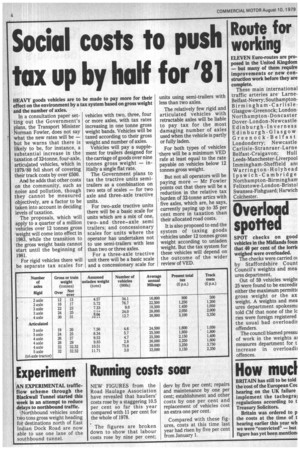Social costs to push tax up by half for '81
Page 6

If you've noticed an error in this article please click here to report it so we can fix it.
HEAVY goods vehicles are to be made to pay more for their effect on the environment by a tax system based on gross weight and the number of axles.
In a consultation paper setting out the Government's plans, the Transport Minister Norman Fowler, does not say what the new rates will be but he warns that there is likely to be, for instance, a substantial increase in the taxation of 32-tonne, four-axle, articulated vehicles, which in 1979/80 fell short of covering their track costs by over £500.
And he adds that other costs on the community, such as noise and pollution, though they cannot be measured objectively, are a factor to be taken into account in deciding levels of taxation.
The proposals, which will apply to a quarter of a million vehicles over 12 tonnes gross weight will come into effect in 1983, while the transition to the gross weight basis cannot start until the beginning of 1981.
For rigid vehicles there will be separate tax scales for vehicles with two, three, four or more axles, with tax rates increasing in one tonne gross weight bands. Vehicles will be taxed according to their gross weight and number of axles.
Vehicles will pay a supplement for trailers designed for the carriage of goods over nine tonnes gross weight initially a single flat rate.
The Government plans to tax the tractive units semitrailers as a combination on two sets of scales for two axle and three-axle tractive units.
For two-axle tractive units there will be a basic scale for units which are a mix of one, twoand three-axle semi trailers; and concessionary scales for units where the operator has undertaken not to use semi-trailers with less than two or three axles.
For a three-axle tractive unit there will be a basic scale and a concessionary scale for units using semi-trailers with less than two axles.
The relatively few rigid and articulated vehicles with retractable axles will be liable to pay tax for the most damaging number of axles used when the vehicle is partly or fully laden.
For both types of vehicles there will be a minimum VED rate at least equal to the rate payable on vehicles below 12 tonnes gross weight.
But not all operators will be paying more Mr Fowler points out that there will be a reduction in the relative tax burden of 32-tonne artics with five axles, which are, he says, currently paying up to 35 per cent more in taxation than their allocated road costs.
It is also proposed to end the system of taxing goods vehicles under 12 tonnes gross weight according to unladen weight. But the tax system for these vehicles will depend on the outcome of the wider review of VED.




































































































